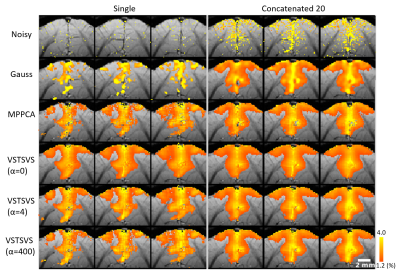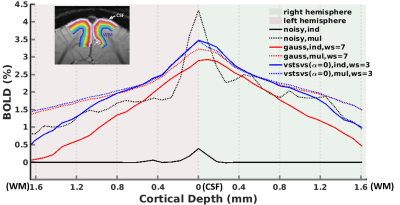Wei Zhu1, Xiaodong Ma1, Xiao-Hong Zhu1, Kamil Uğurbil1, Wei Chen1, and Xiaoping Wu1
1University of Minnesota, Minneapolis, MN, United States
1University of Minnesota, Minneapolis, MN, United States
Our method when used to denoise single-run fMRI data
enhances the performance for estimation of BOLD activations to a level
comparable to what is achievable with averaged 20 runs but using conventional
Gaussian smoothing.

Fig. 4 In-vivo
experiment: comparing denoising performances for VST-SVS vs Gaussian smoothing
(Gauss) vs MPPCA in terms of BOLD percent change. Note that the proposed
VST-SVS method outperformed the conventional Gaussian smoothing when both used
to denoise a single run, increasing activation areas to a level visually
comparable in size to what was achievable with Gaussian smoothing but using all
20 runs.

Fig. 5 In-vivo experiment: laminar BOLD profiles are shown for both
hemispheres and are displayed for noisy data (black lines), Gaussian smoothing
(red lines), and VST-SVS (α=0,
patch averaging) (blue lines) derived from either single run (ind,
solid lines) or concatenated 20 runs (mul, dashed lines). Note that the use of
VST-SVS to denoise a single run gave rise to a laminar profile comparable to
that achievable with 20 runs using conventional Gaussian smoothing.